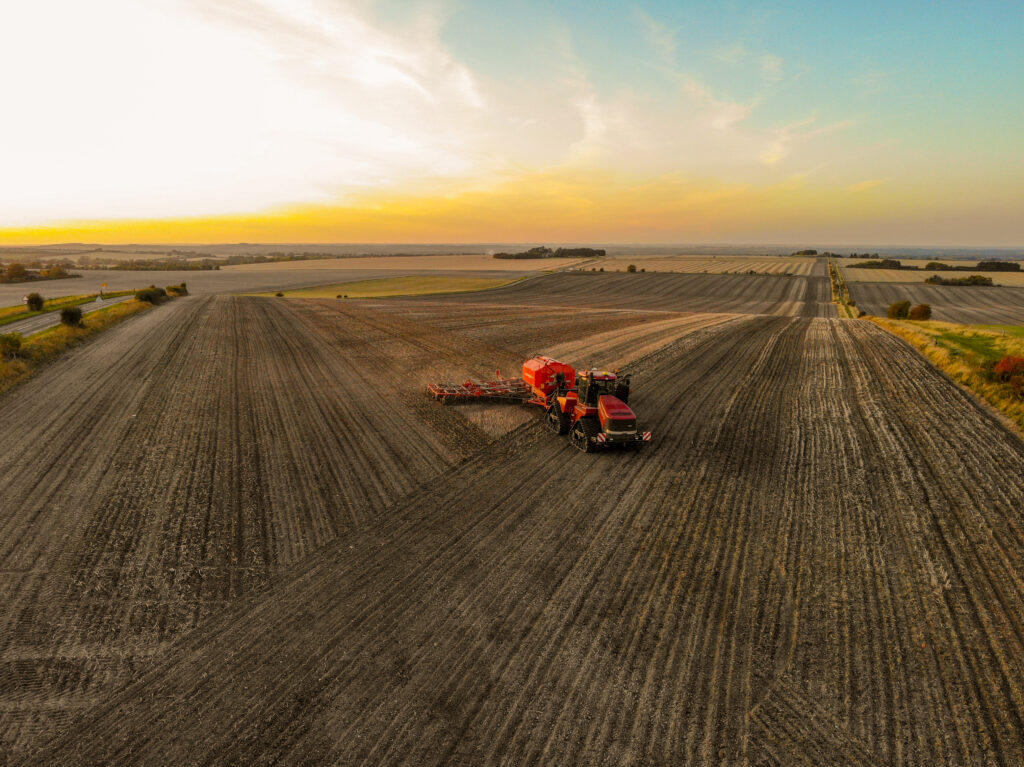Author: Laura Saunders
Land and Property Professionals
We sell, rent, manage, survey, plan and advise...what can we do for you?
We sell, rent, manage, survey, plan and advise...what can we do for you?

No matter who wins the next election, the number of new homes to be built on greenfield sites is set to rocket. The opportunities for landowners in key locations will greatly increase, but there will be winners and losers.
Politicians of all colours have played football with the housing market for years. In one breath they voice support for first-time buyers wanting a home at an affordable price and they criticise the housebuilding industry for failing to increase production. In the next, they vow to protect the countryside from unwelcome development, pretending that new homes can all be built on brownfield sites and allowing local authorities to fail to plan for sufficient new houses.
Both main parties aim for around 300,000 new homes per year, but for decades they have barely provided two thirds that number. Meanwhile, the population continues to grow, and houses remain unaffordable to many. Supply is not matching demand.

What is causing this shortfall? The Competitions and Markets Authority has recently submitted a major housebuilding market study, concluding:
Nothing will change until after the election, but whoever wins, it is likely that our housing shortage will be a growing political problem. Both main parties know that housing is the second basic need for the populace, after putting food on the table. The backlog has now grown too large to be ignored and, one way or another, housebuilding will be increased over coming years, driven by central government. Most of the increase will be on greenfield sites adjoining existing settlements.
Some will mourn the loss of parts of our cherished countryside and that is understandable. However, for some landowners, a windfall from a development scheme can be a much-needed shot in the arm for a farming business or for an expanding family. Many of our farming clients have benefited from modest developments on the edge of a larger village or town and often those developments prove to be well built, while providing valuable contributions to community facilities by way of a Section 106 agreement.
The process of promoting land for future development is very specialised and must be handled with skill and care. There are many pitfalls, including the possibility that land could be compulsorily acquired at agricultural values. The development world is populated by many who will take advantage of the unwary. Nevertheless, there are many professional land agents and land promoters across the country who work together to produce the best possible results for landowners and I would advise anybody with land with potential to take professional advice at an early stage.
There is no doubt that opportunities for the right land must increase considerably in coming years. In terms of housing supply, the next general election cannot come too soon.
If you would like more information or to find out how our Development department can help you, then please contact David or Andrew.

In 2018, the Government began to undertake consultations regarding the use of exemption licences at permitted waste sites, with the aim of improving operator competence standards at such sites and reducing the use of the exemptions to cover illegal activity. The consultations raised a series of amendments to be made to the key exemptions that were deemed to encourage poor environmental practice or illegal activity. The proposed reforms make changes to storage limits on waste, the waste that can be used for specific exemptions and to remove some exemptions all together.
Some reforms have already been implemented, such as disallowing multiple exemption licences to be applied for on one site. Further reform on waste records now requires waste operators (i.e. those with a waste exemption licence or environmental permit) to keep electronic records of storage and movement and to provide these on demand.
The new reforms are proposed to come into force in autumn 2024, although a formal date has not yet been released. Each exemption has a specific transition period, setting a period in the months following the reform implementation by which waste operators must conform with the changes. The transition period applies to existing licences and licences registered in the transition period. For those exemptions that are due to be removed, waste operators will be required to apply for an environmental permit to continue these activities.
The table below details the changes to the individual exemptions:
| Exemption | Reform | Transition Period (months) |
| U1 – Use of Waste in Construction | Change to waste codes Name change | 12 |
| U16 – Using Depolluted End-of-Life Vehicles for Parts | Removal of exemption | 3 |
| T4 – Preparatory Treatment of Waste by Baling, Sorting, Shredding, Pulverising, Densifying, Crushing, Granulating or Compacting It | Change to storage conditions Name change | 6 |
| T6 – Treatment of Waste Wood and Waste Plant Matter by Chipping, Shredding, Cutting or Pulverising | Change to storage conditions Name change | 6 |
| T8 – Mechanically Treating End-of-Life Tyres | Removal of exemption | 3 |
| T9 – Recovering Scrap Metal | Removal of exemption | 3 |
| T11 – Repairing or Refurbishing Waste Electrical and Electronic Equipment | Additional fee for licence | N/A |
| T12 – Manually Treating Waste | Changes to storage conditions | 6 |
| T21 – Recover Waste at Waste Water Treatment Works | Change to waste codes | N/A |
| D7 – Burning Waste in the Open | Change to waste codes Name change | 12 |
| S1 – Store Waste in Secure Containers | Change to storage conditions Change to waste codes | 12 |
| S2 – Temporary Storage of Waste at a Secure Site Pending Recovery Elsewhere | Change to storage conditions Change to waste codes | 12 |
| S3 – Storing Sludge | Change to volume of waste required for exemption | N/A |
For further information on the waste exemption regulation reforms, please contact Emily.

As large-scale solar and battery projects gain popularity, more and more landowners are being approached by companies who wish to take out option and lease agreements across their land. Documentation from each company will vary, with some heads of terms being very comprehensive, whilst others are a little more simplistic. Given the number of projects that have popped up in our region, we have put together some pointers on some of the less common factors people need to give thought to before entering into an agreement with a developer.
Most developers will request an initial exclusivity period where the landowner agrees not to engage with any other party whilst the developer confirms grid connection and carries out an initial planning assessment. Thought should be given to the length of this exclusivity period and what surveys, if any, the developer may undertake during that time.

Whilst the prospect of generating renewable energy can be exciting, it is important to consider any existing agreements that you have entered your land into, and the limitations associated with these. With the decline in Basic Payment Scheme payments, more landowners have turned to Countryside Stewardship and the Sustainable Farming Incentive to supplement their income. However, these schemes come with a 3 or 5-year term respectively. It is therefore important to consider the timeframes for each stage of the project – will the solar tenant have achieved planning permission before the end of your land management scheme? Will they be prepared to compensate you if this is the case? Environmental schemes may place limits on the surveys that the solar tenant can do, as you don’t want to be penalised by the Rural Payments Agency because the solar tenant has dug a soil sample out of your flower-rich margins!
There will also be restrictions relating to existing tenancies on the land. It is important to check the termination provisions of such agreements and whether compensation may need to be paid to the existing tenant if the option agreement is acted on during the term of their tenancy.

There is great variation across the board in the value of option agreement payments and lease rents. Additionally, some solar companies will offer a lower rent for a lease but with extra one-off payments. It is important to consider the long-term income potential before deciding whether to take one-off payments or a higher long-term rent.
Solar companies are keen to fix their lease rents for the long term and may try to cap rent reviews in the heads of terms. It is usual to see rent reviews in line with an index, such as Consumer Price Index, but recent high inflation has seen some solar companies try to cap the increases to a certain percentage per year. It is often possible to negotiate at the heads of terms stage.
Decommissioning the site at the end of the lease comes at a cost to the solar company and therefore must be budgeted for. A landowner must ensure funds are set aside so a tenant doesn’t disappear at the end of the lease, leaving the landowner to clear up. Most leases include terms for a ‘decommissioning bond’, under which money is set aside annually by the solar company so that money is available for decommissioning when the time comes. The earlier this payment begins, the less risk to a landlord that they will be left with an issue at the end of the lease. It is also important that the lease includes provision for regular reviews of the bond amount to ensure adequate funds will be held at the end of the lease.
Generally, the developer will cover the landowner’s reasonable legal and surveyor’s fees. However, they will often put a cap on that amount. It is important to ensure the cap is at a suitably high level to cover all your costs up to and including the signing of the lease. The developer should also give an undertaking to cover these costs should the transaction fail to complete, other than where the landowner has acted unreasonably.
As a landowner, it is important to get the best deal as possible, but it can be difficult to see the next steps when looking at pages of legal jargon. If you would like more information on how we can help you to negotiate a solar agreement, please contact our Rural Team on 01234 352201.

On 25th March, the Department for Environment, Food and Rural Affairs (DEFRA) announced that it would be applying a cap to the amount of land farmers can put into certain Sustainable Farming Incentive (SFI) actions. This affects those actions which take land out of production, in a bid to protect food security.
The cap of 25% of the holding has been applied to the following actions for applications submitted after midnight on 25th March 2024. Your application won’t be affected if you applied before this.
AHL1: Pollen and nectar flower mix
AHL2: Winter bird food on arable and horticultural land
AHL3: Grassy field corners or blocks
IGL1: Take improved grassland field corners or blocks out of management
IGL2: Winter bird food on improved grassland
IPM2: Flower-rich grass margins, blocks, or in-field strips
If you require assistance with an application for SFI or Countryside Stewardship, please contact a member of our Rural team on 01234 352201.

After the Department for Environment, Food and Rural Affairs (DEFRA) announced the gradual removal of the Basic Payment Scheme (BPS), many farmers have turned to environmental stewardship schemes to supplement their income. Now that we are into the delinked payments period, it was thought that the requirement to declare land uses in your fields each year would have ended. However, recent guidance from DEFRA indicates that you will still be required to declare the land uses (cropping) within your field parcels annually, so that options on stewardship schemes can be cross-checked to ensure compatibility with the cropping system.
Essentially this means that if you are in Environmental or Countryside Stewardship, before you complete the annual claim, you must log in to the Rural Payments Agency online service and update the cropping/land use in each field.
For those of you whom we complete the annual claims on your behalf, we will update the land use codes but will need the cropping information from you as we did when completing the Basic Payment application.
Should you need help with updating your land use codes or part of your stewardship annual claim, please contact a member of our Rural team on 01234 352201.

In England, Biodiversity Net Gain (BNG) has become mandatory from 12th February 2024. Development must now achieve a 10% BNG measured against the pre-development biodiversity value of the on-site habitat.
This 10% increase can be achieved through on-site or off-site biodiversity gains or statutory biodiversity credits. Once planning permission has been granted, the biodiversity gain condition will be imposed. A Biodiversity Gain Plan must be submitted and approved by the Local Planning Authority (LPA) before the commencement of the development.
What will be exempted from BNG requirements?

What do you need to prepare in respect of BNG in advance of a planning application?
If you would like more information on the above or would like to find out how our Planning team can help you navigate the additional BNG requirements associated with a planning application, please contact Abel Bunu, Principal Planner on 01234 362891 or David Sawford, Partner & Chartered Building Surveyor on 01234 362909.

A Red Book valuation is a formal opinion of value provided by a Chartered Surveyor who is a Member of the Royal Institution of Chartered Surveyors (RICS) prepared in accordance with the RICS Valuation Standards, which are commonly referred to as the Red Book.
The Red Book sets out clear standards that the valuer must follow. It outlines that a valuation is to be undertaken with high standards of investigation, inspection, analysis and justification and can only be carried out by fully qualified RICS Registered Valuers.
When is a Red Book Valuation Needed?
There are many occasions when a Red Book valuation will be required that we can help with. These include:
The high standards required of the Red Book mean that these valuations can be used for legislative requirements and negotiations. The end valuation is a document that is clear, well researched, justified and ultimately useful to the instructing party.

Red Book Valuation or Market Appraisal?
A Red Book valuation differs from a market appraisal, which is an informal opinion/estimate the guide price for a property at sale This is very often carried out by estate agents, with a long-term view of gaining the instruction to market and sell the subject property so may be more focussed on winning the instruction that reporting the correct value.
The Robinson & Hall Team
Robinson & Hall LLP has many RICS qualified Registered Valuers who are able to provide Red Book valuations for a wide range of property types, to include rural, development, commercial and residential.
If you would like to gain more information or obtain a quote, please do not hesitate to contact the team on 01234 352201.

The Farming Equipment and Technology Fund (FETF) provides a contribution to farm businesses to invest in equipment and technology that will help them develop more sustainable farming, horticultural and forestry systems. The fund has now been in existence for two years, and over 3,000 applications were made in 2022-23. However, those that have already received a grant could still be eligible to apply for further funding.
For 2024 applications, the funding has been split into three separate grants as follows:
As applicants can apply for any of the three grants, each business could receive up to £125,000. Payments received will contribute to 50-60% of the average cost of the item selected (or the actual cost if this is lower).
The FETF focuses on farmers, horticulturalists, forestry owners and contractors. Please note that not all livestock farming systems are eligible and applicants should make their own enquiries before registering with the scheme. Application for the FETF opens shortly, with two further windows to open later in the year.

Productivity Items
There are now 85 different items that can be applied for under the productivity grant. 24 new items are introduced in 2024, based on feedback from surveys conducted by the Department for Environment, Food & Rural Affairs (DEFRA). New technologies and equipment are categorised by farming system and include a tractor-powered electric desiccator for weed and plant control, a mobile tractor-powered livestock total feed ration mixer, and a forestry harvesting head with bark stripper.
Popular productivity equipment continues to be a robotic drill and guided hoe, automatic tree planters and a robotic silage pusher.
Slurry Management Items
There are now 17 different items of slurry equipment that can be applied for. Following feedback from the DEFRA surveys, the specification for the equipment has been widened to allow screw press, screen press and mobile separators.

Animal Health and Welfare
There are now 130 animal health and welfare items that can be applied for, including 29 new items.
Applications are scored based on their contribution to the Animal Health and Welfare Pathway priorities. Applicants can boost their application by 20% by proving they have discussed the items applied for with a vet.
Popular health and welfare equipment continue to be handling systems, disinfecting equipment and remote monitoring systems.
Application Details
Applicants should check their eligibility before applying for grants under the scheme. Each item applied for is assigned a score out of 100. When the applicant sends in their grant application, the scores for each item are added together, and divided by the number of items applied for. This average score is then used to rank applications; funds will be granted to the highest scoring applications first and will continue down the list until the quota for that application window is reached. However, do not worry if your application is rejected in one application window, as you are eligible to reapply at later application windows in the year.
Payments from the grant are received in arrears, meaning that you must prove you have the funds to cover the full cost initially. Applicants cannot utilise money from other UK public funds, lease or hire purchase schemes. Applications cannot be made for items which are brought using part exchange, second hand or ex demos, items bought on hire purchase or lease, or items already purchased prior to application. Claiming the grant can only occur once the item has been paid for, delivered, installed and made operational.
If you are interested in applying for the scheme or wish to request more information, please contact a member of our Rural team on 01234 352201 or email bedford@robinsonandhall.co.uk

The Countryside and Rights of Way Act 2000 introduced a cut-off date of 1st January 2026, after which time historic public rights of way cannot be recorded. However, the Government has now extended the deadline for this cut off to 1st January 2031. This affects landowners, as there is generally significant public interest from people who enjoy accessing the countryside and want to ensure that there are no historical public rights of way lost.

Additionally, after the cut-off date, the Definitive Map will not be able to be changed to correct any historical errors. This means that if a route for a public right of way is shown incorrectly, a landowner will be unable to apply to have this corrected. It is therefore important that if a landowner believes routes are recorded incorrectly they act now, especially as local highway authorities tend to have a large backlog of cases.
A new public right of way can be recognised when a route has been used for at least 20 years without interruption. The onus is on the landowner to prove that they have actively tried to prevent third parties from acquiring rights over their property. One way this can be done is by erecting signs and notices which explicitly state that public access is prohibited, but they must be maintained and located close to the land that they are looking to protect. Similarly, locking gates and/or blocking the access to routes which are not public rights of way can help to express that the landowner does not want that section of land dedicated as a public right of way.
If a landowner gives the public permission to use a particular route as a permissive right of way, the public’s ability to claim it as a public right of way is limited. This may be useful if there are particular routes which the landowner is willing to allow the public to use but where they do not want that right to become permanent. It is important to document permissive paths and also erect signs on the land confirming the use of the route is by permission.
Other ways in which a landowner can protect against new public rights of ways being created is through completing a landowner statement under Section 31(6) of the Highways Act 1980. They can also complete a statement under Section 15A of the Commons Act 2006 which works in the same way as a Section 31 deposit but against new applications for village greens. The statement is submitted to the local authority and allows a landowner to legally protect themselves against inadvertently granting any new rights of way on their land. Effectively, the landowner draws a line in the sand to prevent commencement of any new 20 year periods of use.
We can prepare the required documents required under S31 (6) and 15A on your behalf. For more information or to find out how our Rural Property & Business department can help you please contact 01234 352201 or 01280 428010 or email bedford@robinsonandhall.co.uk

A Grade II listed timber frame farmhouse was vacated by a farm tenant and handed back to the estate owners in a worn out and unlettable condition.
Robinson & Hall’s building surveyors were instructed to advise and assist the client with obtaining statutory consents. We were also tasked to project manage the refurbishment works to make the property suitable to let again.
The initial inspection revealed several concerning defects including:
Following the initial inspection, Robinson & Hall:


Once the statutory consents had been obtained, including building regulations consent, a full specification was prepared and the construction works were tendered to contractors with traditional repair/building skills.
A family run building contractor was appointed and the repair and alteration works were carried out from August 2022 through to June 2023.
The works were contract administered by Robinson & Hall utilising The Joint Contracts Tribunal (JCT) Contract, which we always recommend in order to ensure that the parties’ responsibilities and obligations are fully understood.
Upon practical completion, the JCT Contract included a six-month rectification period. During this time, the contractor was responsible for defects associated with the works or materials utilised.

David Sawford attended at the end of the rectification period to check if any works were required prior to the end of the contractor’s responsibility and was thrilled to meet the new tenants who were loving the property and had made the house a home.
Upon the completion of the project, a set of as-built documents and maintenance recommendations were provided as, particularly with traditional historic buildings, a level of continual maintenance is required to prevent deterioration.
If you have a listed building or historic structure in need of refurbishment or require maintenance advice, please contact David.